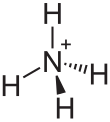Ammonium phosphinate
| |||
| Names | |||
|---|---|---|---|
| Other names Ammonium hypophosphite | |||
| Identifiers | |||
3D model (JSmol) |
|||
| ECHA InfoCard | 100.029.333 | ||
| EC Number |
| ||
CompTox Dashboard (EPA) |
|||
| |||
| |||
| Properties | |||
| H6NO2P | |||
| Molar mass | 83.027 g·mol−1 | ||
| Appearance | colorless crystals | ||
| Density | 1.634 g/cm3 | ||
| Melting point | 200 | ||
| soluble | |||
| Hazards | |||
| GHS labelling: | |||
 [1] [1]
| |||
| Warning | |||
| H315, H319, H335[2] | |||
| P261, P305, P338, P351[2] | |||
Except where otherwise noted, data are given for materials in their standard state (at 25 °C [77 °F], 100 kPa). | |||
Ammonium phosphinate is a chemical compound with the chemical formula NH4PH2O2.[3][4] This is a salt of ammonium and phosphoric acid.
Synthesis
The effect of ammonia solution on phosphoric acid solution:
- HPH2O2 + NH3 → NH4PH2O2
Physical properties
Ammonium phosphonate forms colorless crystals of rhombic system, spatial group C mma, cell parameters a = 0.757 nm, b = 1.147 nm, c = 0.398 nm, Z = 4.[5]
The compound is soluble in water and ethanol, but insoluble in acetone.[6]
Uses
The compound is usually used as a catalyst for the production of polyamide.[2]
References
- ^ "Ammonium hypophosphite". Sigma Aldrich. Retrieved 2 December 2024.
- ^ a b c "Ammonium phosphinate | 7803-65-8, Ammonium phosphinate Formula". ECHEMI. Retrieved 2 December 2024.
- ^ Russian Chemical Reviews. Russian Academy of Sciences, The Royal Society of Chemistry and Turpion Limited. 1980. p. 49. Retrieved 2 December 2024.
- ^ Emergency Planning and Community RightToKnow Act section 313 reporting guidance for the textile processing industry. DIANE Publishing. p. C-14. ISBN 978-1-4289-0164-3. Retrieved 2 December 2024.
- ^ Weakley, T. J. R. (18 August 2011). "The Crystal Structures of Ammonium Phosphinate (Hypophosphite) and Guanidinium Ph08phinate, and the Cell Parameters of Hydrazinium(2+) Phosphinate". Journal of the Chemical Society of Pakistan. 1 (2): 37. Retrieved 2 December 2024.
- ^ Armarego, W. L. F. (27 August 2022). Purification of Laboratory Chemicals: Part 2 Inorganic Chemicals, Catalysts, Biochemicals, Physiologically Active Chemicals, Nanomaterials. Butterworth-Heinemann. p. 8. ISBN 978-0-323-95828-8. Retrieved 2 December 2024.


